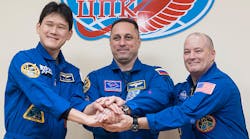A three-man space crew of American and Japanese rookie astronauts and an experienced Russian cosmonaut successfully docked at the International Space Station Tuesday to begin a six-month mission.
NASA TV footage showed the Soyuz MS-07 capsule containing Scott Tingle of NASA, Anton Shkaplerov of Roscosmos and Norishige Kanai of the Japan Aerospace Exploration Agency dock at the ISS at 0839 GMT following a two-day flight.
A NASA TV commentator hailed the “textbook arrival” of the trio at the orbital lab positioned more than 250 miles above “the boot of Italy” at the time of contact.
In a statement, Roscosmos also confirmed that the Soyuz MS-07 had “successfully docked” at the ISS.
The space travelers blasted off from Russia’s Baikonur cosmodrome in Kazakhstan in freezing conditions Sunday and will now join Russia’s Alexander Misurkin and NASA pair Mark Vande Hei and Joe Acaba currently aboard the ISS.
Both Tingle, 52, and Kanai, 40, are in space for the first time, but flight commander Shkaplerov, 43, is an experienced hand. The former Russian military pilot has spent exactly a year in space over two missions and will mark his birthday in orbit for the third time in February next year.
Kanai is the youngest astronaut in the history of the Japanese space agency, and the last of a trio of Japanese astronauts who were certified for travel to the ISS back in 2011. U.S. Navy captain Tingle is a graduate of Purdue University, which also counts space legend Neil Armstrong among its alumni.
While most flights to the ISS now take around six hours, the trio took the more circuitous two-day route due to the lab’s position in space at the time of the launch.
Tuesday’s docking marks a prompt crew rotation after Sergei Ryazansky of Roscosmos, NASA’s Randy Bresnik and European Space Agency astronaut Paolo Nespoli returned to Earth on Thursday.
NASA stopped its own manned launches to the ISS in 2011, but recently moved to increase the crew complement on the U.S. section of the ISS to four as the Russians cut theirs to two in a cost-saving measure announced last year.
The ISS laboratory, a rare example of American and Russian cooperation, has been orbiting Earth at about 17,136 mph since 1998.
Copyright Agence France-Presse, 2017



